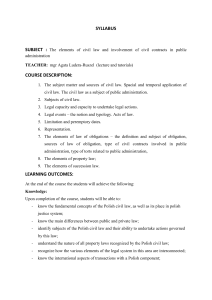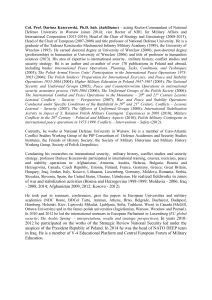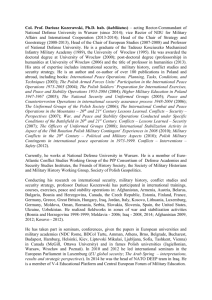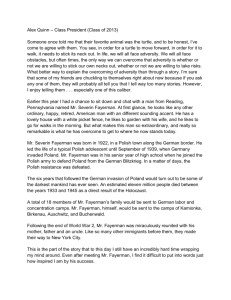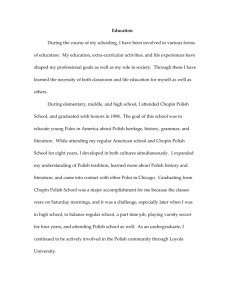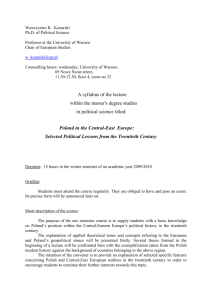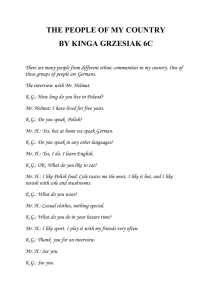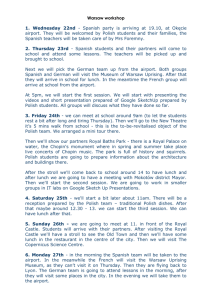Polish resistance movement in World War II
advertisement
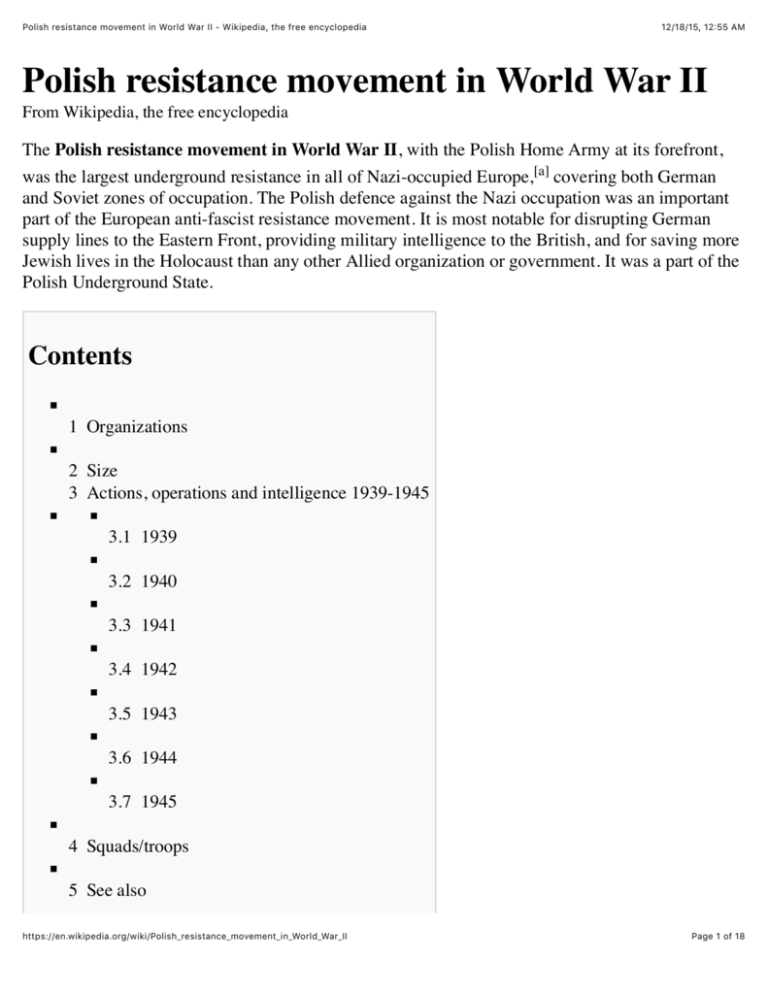
Polish resistance movement in World War II - Wikipedia, the free encyclopedia 12/18/15, 12:55 AM Polish resistance movement in World War II From Wikipedia, the free encyclopedia The Polish resistance movement in World War II, with the Polish Home Army at its forefront, was the largest underground resistance in all of Nazi-occupied Europe,[a] covering both German and Soviet zones of occupation. The Polish defence against the Nazi occupation was an important part of the European anti-fascist resistance movement. It is most notable for disrupting German supply lines to the Eastern Front, providing military intelligence to the British, and for saving more Jewish lives in the Holocaust than any other Allied organization or government. It was a part of the Polish Underground State. Contents 1 Organizations 2 Size 3 Actions, operations and intelligence 1939-1945 3.1 1939 3.2 1940 3.3 1941 3.4 1942 3.5 1943 3.6 1944 3.7 1945 4 Squads/troops 5 See also https://en.wikipedia.org/wiki/Polish_resistance_movement_in_World_War_II Page 1 of 18 Polish resistance movement in World War II - Wikipedia, the free encyclopedia 12/18/15, 12:55 AM 6 Notes 7 References 8 External links Organizations The largest of all Polish resistance organizations was the Armia Krajowa (Home Army, AK), loyal to the Polish government in exile in London. The AK was formed in 1942 from the Union for Armed Combat (Związek Walki Zbrojnej or ZWZ, itself created in 1939) and would eventually incorporate most other Polish armed resistance groups (except for the communists and some far-right groups).[1][2] It was the military arm of the Polish Underground State and loyal to the Polish government in Exile.[1] Most of the other Polish underground armed organizations were created by a political party or faction, and included: Soldiers from Kolegium "A" of Kedyw on Stawki Street in Wola district - Warsaw Uprising 1944 The Bataliony Chłopskie (Peasants' Battalions). Created by the leftist People's Party around 1940–1941, it would partially merge with AK around 1942–1943.[3] The Gwardia Ludowa WRN (People's Guard of WRN) of Polish Socialist Party (PPS) (joined ZWZ around 1940, subsequently merged into AK)[4][5] Polish partisans from Kielce area - unit The Konfederacja Narodu (Confederation of "Jędrusie" 1945 the Nation). Created in 1940 by far-right Obóz Narodowo Radykalny-Falanga (National Radical Camp Falanga).[6] It would partially merge with ZWZ around 1941 and finally join AK around fall 1943. https://en.wikipedia.org/wiki/Polish_resistance_movement_in_World_War_II Page 2 of 18 Polish resistance movement in World War II - Wikipedia, the free encyclopedia 12/18/15, 12:55 AM The Narodowa Organizacja Wojskowa (National Military Organisation), established by the National Party in 1939, mostly integrated with AK around 1942.[7] Narodowe Siły Zbrojne (National Armed Forces); created in 1943 from dissatisfied NOW units, which refused to be subordinated to the AK.[7][8][9] The Obóz Polski Walczącej (Camp of Fighting Poland), established by the Obóz Zjednoczenia Narodowego (Camp of National Unity) around 1942, subordinated to AK.[10] in 1943. The largest groups that refused to join the AK were the National Armed Forces and the pro-Soviet and communist People's Army (Polish Armia Ludowa or AL), backed by the Soviet Union and established by the Polish Workers' Party (Polish Polska Partia Robotnicza or PPR).[11] "Within the framework of the entire enemy intelligence operations directed against Germany, the intelligence service of the Polish resistance movement assumed major significance. The scope and importance of the operations of the Polish resistance movement, which was ramified down to the smallest splinter group and brilliantly organized, have been in (various sources) disclosed in connection with carrying out of major police security operations." Heinrich Himmler, 31 December 1942[12] Size In February 1942, when AK was formed, it numbered about 100,000 members.[2] In the beginning of 1943, it had reached a strength of about 200,000.[2] In the summer of 1944 when Operation Tempest begun AK reached its highest membership numbers, though the estimates vary from 300,000[13] to 500,000.[14] The strength of the second largest resistance organization, Bataliony Chłopskie (Peasants' Battalions), can be estimated for summer 1944 (at which time they were mostly merged with AK[3]) at about 160,000 men.[15] The third largest group include NSZ (National Armed Forces) with approximately 70,000 men around 1943-1944; only small parts of that force were merged with AK.[8] At its height in 1944, the communist Armia Ludowa, never merged with AK, numbered about 30,000 people.[11] One estimate for the summer 1944 strength of AK and its allies, including NSZ, gives the strength of 650,000.[16] Overall, the Polish resistance have often been described as the largest or one of the largest resistance organizations in World War II Europe.[a] Actions, operations and intelligence 1939-1945 https://en.wikipedia.org/wiki/Polish_resistance_movement_in_World_War_II Page 3 of 18 Polish resistance movement in World War II - Wikipedia, the free encyclopedia 12/18/15, 12:55 AM 1939 On November 9, 1939, two soldiers of the Polish army—Witold Pilecki and Major Jan Włodarkiewicz—founded the Secret Polish Army (Tajna Armia Polska, TAP), one of the first underground organizations in Poland after defeat.[17] Pilecki became its organizational commander as TAP expanded to cover not only Warsaw but Siedlce, Radom, Lublin and other major cities of central Poland.[18] By 1940, TAP had approximately 8,000 men (more than half of them armed), some 20 machine guns and several anti-tank rifles. Later, the organization was incorporated into the Union for Armed Struggle (Związek Walki Zbrojnej), later renamed and better known as the Home Army (Armia Krajowa).[19] 1940 Witold Pilecki - founder of TAP organisation and the secret agent of Polish resistance in Auschwitz In March 1940, a partisan unit of the first guerrilla commanders in the Second World War in Europe under Major Henryk Dobrzański "Hubal" completely destroyed a battalion of German infantry in a skirmish near the village of Huciska. A few days later in an ambush near the village of Szałasy it inflicted heavy casualties upon another German unit. To Major Henryk counter this threat the German authorities Dobrzański formed a special 1,000 men strong antiaka "Hubal" partisan unit of combined SS–Wehrmacht forces, including a Panzer group. Although "Hubal" and his partisan unit the unit of Major Dobrzański never exceeded 300 men, the winter 1940 Germans fielded at least 8,000 men in the area to secure it.[20][21] In 1940, Witold Pilecki, a member of the Polish resistance, presented to his superiors a plan to enter Germany's Auschwitz concentration camp, gather intelligence on the camp from the inside, and organize inmate resistance.[22] The Home Army approved this plan, provided him a false identity card, and on September 19, 1940, he deliberately went out during a street roundup in Warsaw łapanka, and was caught by the Germans along with other civilians and sent to Auschwitz. In the https://en.wikipedia.org/wiki/Polish_resistance_movement_in_World_War_II Page 4 of 18 Polish resistance movement in World War II - Wikipedia, the free encyclopedia 12/18/15, 12:55 AM camp he organized the underground organization -Związek Organizacji Wojskowej - ZOW.[23] From October 1940, ZOW sent its first report about the camp and the genocide in November 1940 to Home Army Headquarters in Warsaw through the resistance network organized in Auschwitz.[24] During the night of January 21–22, 1940, in the Soviet-occupied Podolian town of Czortków, the Czortków Uprising started; it was the first Polish uprising during World War II. Anti-Soviet Poles, most of them teenagers from local high schools, stormed the local Red Army barracks and a prison, in order to release Polish soldiers kept there. At the end of 1940 Aleksander Kamiński created a Polish youth łapanka, possibly the one in which Witold Pilecki was captured in autumn 1941, Warsaw, Żoliborz. resistance organization - "Wawer".[25] It was part of the Szare Szeregi (the underground Polish Scouting Association). This organisation carried out many minor sabotage operations in occupied Poland. Its first action was drawing graffiti in Warsaw around Christmas Eve of 1940 commemorating the Wawer massacre.[26] Members of the AK Wawer "Small Sabotage" units painted "Pomścimy Wawer" ("We'll avenge Wawer") on Warsaw walls. At first they painted the whole text, then to save time they shortened it to two letters, P and W. Later they invented Kotwica -"Anchor" - which became the symbol of all Polish resistance in occupied Poland.[27] 1941 From April 1941 the Bureau of Information and Propaganda of the Union for Armed Struggle started Operation N headed by Tadeusz Żenczykowski. It involved sabotage, subversion and blackpropaganda activities.[28] From March 1941, Witold Pilecki's reports were forwarded to the Polish government in exile and through it, to the British and other Allied governments. These reports informed the Allies about the Holocaust and were the principal source of intelligence on Auschwitz-Birkenau for the Western Allies.[29] On March 7, 1941, two Polish agents of the Home Army killed Nazi collaborator actor Igo Sym in his apartment in Warsaw. In reprisal, 21 Polish hostages were executed. Several Polish actors were also arrested by the Nazis and sent to Auschwitz, among them such notable figures as directors Stefan Jaracz and Leon Schiller. https://en.wikipedia.org/wiki/Polish_resistance_movement_in_World_War_II Page 5 of 18 Polish resistance movement in World War II - Wikipedia, the free encyclopedia 12/18/15, 12:55 AM In July 1941 Mieczysław Słowikowski (using the codename "Rygor" — Polish for "Rigor") set up "Agency Africa," one of World War II's most successful intelligence organizations.[30] His Polish allies in these endeavors included Lt. Col. Gwido Langer and Major Maksymilian Ciężki. The information gathered by the Agency was used by the Americans and British in planning the amphibious November 1942 Operation Torch[31] landings in North Africa. These were the first large-scale Allied landings of the war, and their success in turn paved the way for the Allies' Italian campaign. 1942 On 20 June 1942, the most spectacular escape from Auschwitz concentration camp took place. Four Poles, Eugeniusz Bendera,[32] Kazimierz Piechowski, Stanisław Gustaw Jaster and Józef Lempart made a daring escape.[33] The escapees were dressed as members of the SS-Totenkopfverbände, fully armed and in an SS staff car. They drove out the main gate in a stolen Rudolf Hoss automobile Steyr 220 with a smuggled report from Witold Pilecki about the Holocaust. The Germans never recaptured any of them.[34] In September 1942 "The Żegota Council for the Aid of the Jews" was founded by Zofia Kossak-Szczucka and Wanda Krahelska-Filipowicz ("Alinka") and made up of Polish Democrats as well as other Catholic activists. Poland was the only country in occupied Europe where there existed such a dedicated secret organization. Half of the Jews who survived the war (thus over 50,000) were aided in some shape or form by Żegota.[35] The best-known activist of Żegota was Irena Sendler, head of the children's division, who saved 2,500 Jewish children by smuggling them out of the Warsaw Ghetto, providing them with false documents, and sheltering them in individual and group children's homes outside the Ghetto.[36] Polish partisan Zdzisław de Ville "Zdzich", member of AK "Jędrusie" with Polish version of the M1918 BAR In 1942 Jan Karski reported to the Polish, British and U.S. governments on the situation in Poland, especially the Holocaust of the Jews. He met with Polish politicians in exile including the prime minister, and members of political parties such as the Socialist Party, National Party, Labor Party, People's Party, Jewish Bund and Poalei Zion. He also spoke to Anthony Eden, the British foreign secretary, and included a detailed statement on what he had seen in Warsaw and Bełżec.[37] https://en.wikipedia.org/wiki/Polish_resistance_movement_in_World_War_II Page 6 of 18 Polish resistance movement in World War II - Wikipedia, the free encyclopedia 12/18/15, 12:55 AM The Zamość Uprising was an armed uprising of Armia Krajowa and Bataliony Chłopskie against the forced expulsion of Poles from the Zamość region under the Nazi Generalplan Ost.[38] The Germans attempted to remove the local Poles from the Greater Zamość area (through forced removal, transfer to forced labor camps, or, in some cases, mass murder) to get it ready for German colonization. It lasted from 1942 until 1944 and despite heavy casualties suffered by the Underground, the Germans failed.[39] On the night from 7 to 8 October 1942 Operation Wieniec started. It targeted rail infrastructure near Warsaw. Similar operations aimed at disrupting German transport and communication in occupied Poland occurred in the coming months and years. It targeted railroads, bridges and supply depots, primarily near transport hubs such as Warsaw and Lublin. 1943 In early 1943 two Polish janitors[40] of Peenemünde's Camp Trassenheide provided maps,[41] sketches and reports to Armia Krajowa Intelligence, and in June 1943 British intelligence had received two such reports which identified the "rocket assembly hall', 'experimental pit', and 'launching tower'. When reconnaissance and intelligence information regarding the V-2 rocket became convincing, the War Cabinet Defence Committee (Operations) directed the campaign's first planned raid (the Operation Hydra bombing of Peenemünde in August 1943) and Operation Crossbow.[42] On March 26, 1943 in Warsaw Operation Arsenal was launched by the Szare Szeregi (Gray Ranks) Polish Underground The successful operation led to the release of arrested troop leader Jan Bytnar "Rudy". In an attack on the prison, Bytnar and 24 other prisoners were freed.[43] In 1943 in London Jan Karski met the then much known journalist Arthur Koestler. He then traveled to the United States and reported to President Franklin D. Roosevelt. His report was a major factor in informing the West. In July 1943, again personally reported to Roosevelt about the situation in Poland. He also met with many other government and civic leaders in the United States, including Felix Frankfurter, Cordell Hull, William Joseph Donovan, and Stephen Wise. Karski also presented his report to media, bishops of various denominations (including Cardinal Samuel Stritch), members of the Hollywood film industry and artists, but without success. Many of those he spoke to did not believe him, or supposed that his testimony was much exaggerated or was propaganda from the Polish government in exile. In April 1943 the Germans began deporting the remaining Jews from the Warsaw ghetto provoking the Warsaw Ghetto Rising, April 19 to May 16. Some units of the AK tried to assist the Ghetto rising, but for the most part the resistance was unprepared and unable to defeat the Germans. One https://en.wikipedia.org/wiki/Polish_resistance_movement_in_World_War_II Page 7 of 18 Polish resistance movement in World War II - Wikipedia, the free encyclopedia 12/18/15, 12:55 AM Polish AK unit, the National Security Corps (Państwowy Korpus Bezpieczeństwa), under the command of Henryk Iwański ("Bystry"), fought inside the ghetto along with ŻZW. Subsequently, both groups retreated together (including 34 Jewish fighters). Although Iwański's action is the most well-known rescue mission, it was only one of many actions undertaken by the Polish resistance to help the Jewish fighters.[44] In one attack, three cell units of AK under the command of Kapitan Józef Pszenny ("Chwacki") tried to breach the ghetto walls with explosives, but the Germans defeated this action.[40] AK and GL engaged the Germans between April 19 and April 23 at six different locations outside the ghetto walls, shooting at German sentries and positions and in one case attempting to blow up a gate.[40] After the failure of the uprising, the Jewish leaders knew they would be crushed, but they preferred to die fighting than wait to be deported to their deaths in the concentration camps. In August 1943 the headquarters of the Armia Krajowa ordered Operation Belt which was one of the large-scale anti-Nazi operations of the AK during the war. By February 1944, 13 German outposts were destroyed with few losses on the Polish side.[45] AK members recovering V-2 from the Bug River. Operation Heads started - action of the serial assassinations Nazi personnel sentenced to death by the Special Courts for crimes against Polish citizens in occupied Poland. On September 7, 1943, the Home Army killed Franz Bürkl during Operation Bürkl. Bürkl was a high-ranking Gestapo agent responsible for the murder and brutal interrogation of thousands of Polish Jews and resistance fighters and supporters. In reprisal, 20 inmates of Pawiak were murdered in a public execution by the Nazis. From November 1943, Operation Most III started. The Armia Krajowa provided the Allies with crucial intelligence on the German V-2 rocket. In effect some 50 kg of the most important parts of the captured V-2, as well as the final report, analyses, sketches and photos, were transported to Brindisi by a Royal Air Force Douglas Dakota aircraft. In late July 1944, the V-2 parts were delivered to London.[46] 1944 On 11 February 1944 the Resistance fighters of Polish Home Army's unit Agat executed Franz Kutschera, SS and Reich's Police Chief in Warsaw in action known as Operation Kutschera.[47][48] In a reprisal of this action 27 February 140 inmates of Pawiak - Poles and Jews were shot in a public execution by the Germans. https://en.wikipedia.org/wiki/Polish_resistance_movement_in_World_War_II Page 8 of 18 Polish resistance movement in World War II - Wikipedia, the free encyclopedia 12/18/15, 12:55 AM May 13–May 14, 1944 the Battle of Murowana Oszmianka the largest clash between the Polish anti-Nazi Armia Krajowa and the Nazi Lithuanian Territorial Defense Force a Lithuanian volunteer security force subordinated to Nazi Germany.[49] The battle took place in and near the village of Murowana Oszmianka in Generalbezirk Litauen Reichskommissariat Ostland. The outcome of the battle was that the 301st LVR battalion was routed and the entire force was disbanded by the Germans soon afterwards.[50] On June 14, 1944 the Battle of Porytowe Wzgórze took place between Polish and Russian partisans, numbering around 3000, and the Nazi German units consisted of between 25000 to 30000 soldiers, with artillery, tanks and armored cars and air support. On 25–26 June 1944 the Battle of Osuchy - one of the largest battles between the Polish resistance and Nazi Germany in occupied Poland during World War II was fought, in what was essentially a continuation of the Zamość Uprising.[51] Polish resistance soldiers from Batalion Zośka during 1944 Warsaw Uprising During 1943 the Home Army built up its forces in preparation for a national uprising. The plan of national anti-Nazi uprising on areas of prewar Poland was code-named Operation Tempest.[52] Preparation began in late 1943 but the military actions started in 1944. Its most widely known elements were Operation Ostra Brama, Lwów Uprising and the Warsaw Uprising.[53][54][55][56] On July 7, Operation Ostra Brama started. Approximately 12,500 Home Army soldiers attacked the German garrison and managed to seize most of the city center. Heavy street fighting in the outskirts of the city lasted until July 14. In Vilnius' eastern suburbs, the Home Army units cooperated with reconnaissance groups of the Soviet 3rd Belorussian Front.[57] The Red Army entered the city on July 15, and the NKVD started to intern all Polish soldiers. On July 16, the HQ of the 3rd Belorussian Front "Gray Wolf" with Polish national flag - German armored fighting vehicle SdKfz 251 captured by the Warsaw insurgents- 8-th "Krybar" Regiment, on August 14, 1944 from 5th SS Panzer Division Wiking. invited Polish officers to a meeting and arrested them.[58][59][60] On July 23 the Lwów Uprising—the armed struggle started by the Armia Krajowa against the Nazi occupiers in Lwów during World War II—started. It started in July 1944 as a part of a plan of allnational uprising codenamed Operation Tempest. The fighting lasted until July 27 and resulted in https://en.wikipedia.org/wiki/Polish_resistance_movement_in_World_War_II Page 9 of 18 Polish resistance movement in World War II - Wikipedia, the free encyclopedia 12/18/15, 12:55 AM liberation of the city.[61] However, shortly afterwards the Polish soldiers were arrested by the invading Soviets and either forced to join the Red Army or sent to the Gulags. The city itself was occupied by the Soviet Union.[62] In August 1944, as the Soviet armed forces approached Warsaw, the government in exile called for an uprising in the city, so that they could return to a liberated Warsaw and try to prevent a communist take-over. The AK, led by Tadeusz Bór-Komorowski, launched the Warsaw Uprising.[63] Soviet forces were less than 20 km away but on the orders of Soviet High Command they gave no assistance. Stalin described the uprising as a "criminal adventure". The Poles appealed to the western Allies for help. The Royal Air Force, and the Polish Air Force based in Italy, dropped some munitions, but it was almost impossible for the Allies to help the Poles without Soviet assistance. The fighting in Warsaw was desperate. The AK had between 12,000 and 20,000 armed soldiers, most with only small arms, against a well-armed German Army of 20,000 SS and regular Army units. Bór-Komorowski's hope that the AK could take and hold Warsaw for the return of the London government was never likely to be achieved. After 63 days of savage fighting the city was reduced to rubble, and the reprisals were savage. The SS and auxiliary units were particularly brutal. After Bór-Komorowski's surrender, the AK fighters were treated as prisoners-of-war by the Germans, much to the outrage of Stalin, but the civilian population were ruthlessly punished. Overall Polish casualties are estimated to be between 150,000–300,000 killed, 90,000 civilians were sent to labor camps in the Reich, while 60,000 were shipped to death and concentration camps such as Ravensbrück, Auschwitz, Mauthausen and others. The city was almost totally destroyed after German sappers systematically demolished the city. The Warsaw Uprising allowed the Germans to destroy the AK as a fighting force, but the main beneficiary was Stalin, who was able to impose a communist government on postwar Poland with little fear of armed resistance. 1945 In March 1945, a staged trial of 16 leaders of the Polish Underground State held by the Soviet Union took place in Moscow - (Trial of the Sixteen).[64][65][66][67] The Government Delegate, together with most members of the Council of National Unity and the C-i-C of the Armia Krajowa, were invited by Soviet general Ivan Serov with agreement of Joseph Stalin to a conference on their eventual entry to the Soviet-backed Provisional Government. They were presented with a warrant of safety, yet they were arrested in Pruszków by the NKVD on 27 and 28 March.[68][69] Leopold Okulicki, Jan Stanisław Jankowski and Kazimierz Pużak were arrested on 27th with 12 more the next day. A. Zwierzynski had been arrested earlier. They were brought to Moscow for interrogation https://en.wikipedia.org/wiki/Polish_resistance_movement_in_World_War_II Page 10 of 18 Polish resistance movement in World War II - Wikipedia, the free encyclopedia 12/18/15, 12:55 AM in the Lubyanka.[70][71][72] After several months of brutal interrogation and torture,[73] they were presented with the forged accusations of "collaboration with Nazi Germany" and "planning a military alliance with Nazi Germany".[74][75] In the latter years of the war, there were increasing conflicts between Polish and Soviet partisans. Cursed soldiers continued to oppose the Soviets long after the war. The last cursed soldier member of the militant anti-communist resistance in Poland was Józef Franczak who was killed with pistol in his hand by ZOMO in 1963. On May 5, 1945 in Bohemia, the Narodowe Siły Zbrojne brigade liberated prisoners from a Nazi concentration camp in Holiszowo, including 280 Jewish women prisoners.[76] The brigade suffered heavy casualties. On May 21, 1945, a unit of the Armia Krajowa, led by Colonel Edward Wasilewski, attacked a NKVD camp located in Rembertów on the eastern outskirts of Warsaw. The Soviets kept there hundreds of Poles,[77][78][79] members of the Home Army,[80] whom they were systematically deporting to Siberia. However, this action of the pro-independence Polish resistance freed all Polish political prisoners from the camp. Between 1944-1946, cursed soldiers attacked many communist prisons in Soviet-occupied Poland —see Raids on communist prisons in Poland (1944–1946). On May 7, 1945 in the village of Kuryłówka, southeastern Poland, the Battle of Kuryłówka started. It was the biggest battle in the history of the Cursed soldiers organization - National Military Alliance (NZW). In battle against Soviet Union's NKVD units anti-communist partisans shot 70 NKVD agents. The battle ended in a victory for the underground Polish forces.[81] From June 10–25, 1945, Augustów chase 1945 (the Polish Obława augustowska) took place. It was a large-scale operation undertaken by Soviet forces of the Red Army, the NKVD and SMERSH, with the assistance of Polish UB and LWP units against former Armia Krajowa soldiers in the Suwałki and Augustów region in Poland. The operation also covered territory in occupied Lithuania. More than 2,000 alleged Polish anticommunist fighters were captured and detained in Russian internment camps. 600 of the "Augustów Missing" are presumed dead and buried in an unknown location in the present territory of Russia. The Augustów Roundup was part of an antiguerilla operation in Lithuania. https://en.wikipedia.org/wiki/Polish_resistance_movement_in_World_War_II Page 11 of 18 Polish resistance movement in World War II - Wikipedia, the free encyclopedia 12/18/15, 12:55 AM List of confirmed sabotage-diversionary actions of the Union of Armed Combat (ZWZ) and Home Army (AK) from 1 January 1941 to 30 June 1944[82] Cumulative number Sabotage / Diversionary Action Type of actions Damaged locomotives 6,930 Delayed repairs to locomotives 803 Derailed transports 732 Transports set on fire 443 Damage to railway wagons Blown up railway bridges Disruptions to electricity supplies in the Warsaw grid Army vehicles damaged or destroyed 19,058 38 638 4,326 Damaged aeroplanes 28 Fuel tanks destroyed 1,167 Fuel destroyed (in tonnes) 4,674 Blocked oil wells 5 Wagons of wood wool destroyed 150 Military stores burned down 130 Disruptions of production in factories Built-in faults in parts for aircraft engines 7 4,710 Built-in faults into cannon muzzles 203 Built-in faults into artillery missiles 92,000 Built-in faults into air traffic radio stations Built-in faults into condensers 107 70,000 Built-in faults into (electro-industrial) lathes 1,700 Damage to important factory machinery 2,872 Various acts of sabotage performed Pre-planned assassinations of Nazi Germans https://en.wikipedia.org/wiki/Polish_resistance_movement_in_World_War_II 25,145 5,733 Page 12 of 18 Polish resistance movement in World War II - Wikipedia, the free encyclopedia 12/18/15, 12:55 AM Squads/troops Antyfaszystowska Organizacja Bojowa Armia Krajowa Armia Ludowa Bataliony Chłopskie Brygada Swiętokrzyska Gwardia Ludowa Gwardia Ludowa WRN Leśni Narodowa Organizacja Wojskowa Narodowe Siły Zbrojne Obóz Polski Wałczącej Państwowy Korpus Bezpieczeństwa Polska Armia Ludowa Szare Szeregi Związek Odwetu Związek Walki Zbrojnej Żydowska Organizacja Bojowa Związek Organizacji Wojskowej Żydowski Związek Wojskowy See also Polish Underground State Polish resistance in France during World War II Anti-fascism Home Army and V1 and V2 Yugoslav Partisans Cursed soldiers Lithuanian resistance during World War II General Government History of Poland (1939–1945) Polish areas annexed by Nazi Germany Polish areas annexed by Soviet Union Polish partisans Resistance during World War II Resistance movement https://en.wikipedia.org/wiki/Polish_resistance_movement_in_World_War_II Page 13 of 18 Polish resistance movement in World War II - Wikipedia, the free encyclopedia 12/18/15, 12:55 AM Operation Ostra Brama Western betrayal Bratnia Pomoc Notes a ^ A number of sources note that the Home Army, representing the bulk of Polish resistance, was the largest resistance movement in Nazi-occupied Europe. Norman Davies writes that the "Armia Krajowa (Home Army), the AK,... could fairly claim to be the largest of European resistance [organizations]."[83] Gregor Dallas writes that the "Home Army (Armia Krajowa or AK) in late 1943 numbered around 400,000, making it the largest resistance organization in Europe."[84] Mark Wyman writes that the "Armia Krajowa was considered the largest underground resistance unit in wartime Europe."[85] The numbers of Soviet partisans were very similar to those of the Polish resistance.[86] References 1. Marek Ney-Krwawicz, The Polish Underground State and The Home Army (1939–45) (http://www.polishresistance-ak.org/2%20Article.htm). Translated from Polish by Antoni Bohdanowicz. Article on the pages of the London Branch of the Polish Home Army Ex-Servicemen Association. Retrieved 14 March 2008. 2. (Polish) Armia Krajowa (http://portalwiedzy.onet.pl/59129,,,,armia_krajowa,haslo.html). Encyklopedia WIEM. Retrieved 2 April 2008. 3. Wojskowy przegla̜d historyczny (in Polish). s.n. 1996. p. 134. 4. http://portalwiedzy.onet.pl/31319,,,,gwardia_ludowa_wrn,haslo.html?drukuj=1 5. HALINA LERSKI (30 January 1996). Historical Dictionary of Poland, 966-1945. ABC-CLIO. p. 665. ISBN 978-0-313-03456-5. 6. Wizje Polski: programy polityczne lat wojny i okupacji, 1939-1944 (in Polish). Elipsa. 1992. p. 416. 7. http://portalwiedzy.onet.pl/69281,,,,narodowa_organizacja_wojskowa,haslo.html 8. Hanna Konopka; Adrian Konopka (1 January 1999). Leksykon historii Polski po II wojnie światowej 1944-1997 (in Polish). Graf-Punkt. p. 130. ISBN 978-83-87988-08-1. 9. http://portalwiedzy.onet.pl/30636,,,,narodowe_sily_zbrojne,haslo.html 10. http://encyklopedia.interia.pl/haslo?hid=91093 11. (Polish) Armia Ludowa (http://encyklopedia.pwn.pl/haslo.php?id=3871193). Encyklopedia PWN. Retrieved 21 December 2006. 12. "Forgotten Holocaust. The Poles under German Occupation 1939-1944" Richard C. Lukas Hippocrene Books New York 1997, ISBN 0-7818-0901-0 13. Roy Francis Leslie, The History of Poland Since 1863, Cambridge University Press, 1983, ISBN 0-52127501-6, Google Print, p.234 (https://books.google.com/books? id=0tYVKUsnw9IC&pg=PA234&dq=%22Armia+Krajowa%22+largest&lr=&as_brr=3&ei=NzzMR_mO IJGSzQSb7cSwCQ&sig=rLD9gO8sIve_RDxnvTLWfMeFlGg) https://en.wikipedia.org/wiki/Polish_resistance_movement_in_World_War_II Page 14 of 18 Polish resistance movement in World War II - Wikipedia, the free encyclopedia 12/18/15, 12:55 AM 14. Stanisław Salmonowicz, Polskie Państwo Podziemne, Wydawnictwa Szkolne i Pedagogiczne, Warszawa, 1994, ISBN 83-02-05500-X, p.317 15. Bogdan Biegalski (1999). Organizacje podziemne na Środkowym Nadodrzu w latach 1945-1956 (in Polish). Lubuskie Towarzystwo Naukowe. p. 61. ISBN 978-83-910109-2-1. 16. Krzysztof Komorowski (2009). Boje polskie 1939-1945: przewodnik encyklopedyczny (in Polish). Bellona. p. 6. ISBN 978-83-7399-353-2. 17. Lidia Świerczek, Pilecki`s life (http://en.pilecki.ipn.gov.pl/portal/rpe/1025/8193/Rotamaster_Witold_Pilecki.html) Institute of National Remembrance. Last accessed on 14 March 2009. 18. Kazimierz Malinowski, Tajna Armia Polska. Znak. Konfederacja Zbrojna. Zarys genezy, organizacji i działalności, Warszawa 1986. ISBN 83-211-0791-5 19. Richard C. Lukas, "Out of the inferno: Poles remember the Holocaust", University Press of Kentucky, 1989, pg. 5, [1] (https://books.google.com/books? id=lz9obsxmuW4C&pg=PA5&dq=Union+for+Armed+Struggle+Home+Army) 20. *Marek Szymanski: Oddzial majora Hubala, Warszawa 1999, ISBN 83-912237-0-1 21. Aleksandra Ziółkowska Boehm: A Polish Partisan's Story (to be published by Military History Press) (http://www.militaryhistorypress.com/PolishPartisanStory.html) 22. Jozef Garlinski, Fighting Auschwitz: the Resistance Movement in the Concentration Camp, Fawcett, 1975, ISBN 0-449-22599-2, reprinted by Time Life Education, 1993. ISBN 0-8094-8925-2 23. Hershel Edelheit, History of the Holocaust: A Handbook and Dictionary, Westview Press, 1994, ISBN 08133-2240-5,Google Print, p.413 (https://books.google.com/books? id=0DkMHTRtQIYC&pg=PA413&dq=Zwi%C4%85zek+Organizacji+Wojskowej&as_brr=3) 24. Adam Cyra, Ochotnik do Auschwitz - Witold Pilecki 1901-1948 [Volunteer for Auschwitz], Oświęcim 2000. ISBN 83-912000-3-5 25. Jan Kamienski, Hidden in the Enemy's Sight: Resisting the Third Reich from Within, Dundurn Press Ltd., 2008, ISBN 1-55002-854-5, Chapter "Messenger work and small sabotage", p.57 (https://books.google.com/books? id=RNmvWjeB36wC&lpg=PT60&dq=Poland%20%22small%20sabotage%22&as_brr=3&pg=PT56#v= onepage&q=Poland%20%22small%20sabotage%22&f=false) 26. Jan Bijata, Wawer, Książka i Wiedza, Warszawa 1973 27. Lesław J. Welker "Symbolika znaków Polski Walczącej", publisher Adam Marszałek ISBN 83-7174-4986 , ISBN 83-7322-090-9 28. Halina Auderska, Zygmunt Ziółek, Akcja N. Wspomnienia 1939-1945 (Action N. Memoirs 1939-1945), Wydawnictwo Czytelnik, Warszawa, 1972 (Polish) 29. Norman Davies, Europe: A History, Oxford University Press, 1996, ISBN 30. Tessa Stirling et al., Intelligence Co-operation between Poland and Great Britain during World War II, vol. I: The Report of the Anglo-Polish Historical Committee, London, Vallentine Mitchell, 2005 31. Major-General M.Z. Rygor Slowikowski, In the Secret Service: the Lighting of the Torch, translated by George Slowikowski and Krystyna Brooks, with foreword by M.R.D. Foot, London, The Windrush Press, 1988 32. Wojciech Zawadzki (2012), Eugeniusz Bendera (1906 – 1970). (https://web.archive.org/web/20131103214327/http://www.psbprzedborz.pl/index.php? option=com_content&view=article&id=50:bendera-eugeniusz) Przedborski Słownik Biograficzny, via Internet Archive. 33. "Byłem Numerem: swiadectwa Z Auschwitz" by Kazimierz Piechowski, Eugenia Bozena KodeckaKaczynska, Michal Ziokowski, Hardcover, Wydawn. Siostr Loretanek, ISBN 83-7257-122-8 https://en.wikipedia.org/wiki/Polish_resistance_movement_in_World_War_II Page 15 of 18 Polish resistance movement in World War II - Wikipedia, the free encyclopedia 12/18/15, 12:55 AM 34. "Auschwitz-Birkenau - The Film about the Amazing Escape from Auschwitz—Now Available on DVD". En.auschwitz.org.pl. 2009-01-13. Retrieved 2011-10-24. 35. Tadeusz Piotrowski (1997). "Assistance to Jews". Poland's Holocaust. McFarland & Company. p. 118. ISBN 0-7864-0371-3. 36. Baczynska, Gabriela; JonBoyle (2008-05-12). "Sendler, savior of Warsaw Ghetto children, dies". Washington Post (The Washington Post Company). Retrieved 2008-05-12. 37. E. Thomas Wood & Stanisław M. Jankowski (1994). Karski: How One Man Tried to Stop the Holocaust. John Wiley & Sons Inc. ISBN 0-471-01856-2 38. Joseph Poprzeczny, Odilo Globocnik, Hitler's Man in the East, McFarland, 2004, ISBN 0-7864-1625-4, Google Print, p.110-111 (https://books.google.com/books? id=gjOO6ui8SIkC&pg=PA110&vq=Zamosc&dq=%22Zamo%C5%9B%C4%87+Uprising%22+wikipedia&source=gbs_search_s&sig=YlJNpg9GF1yU8bl99WYizvmGUys) 39. Joseph Poprzeczny, Odilo Globocnik, Hitler's Man in the East, McFarland, 2004, ISBN 0-7864-1625-4 40. Józef Garliński "Hitler's Last Weapons: The Underground War against the V1 and V2", Times Books, New York 1978 41. Jedd, Joseph (1994). "Poland's Contribution in the Field of Intelligence to the Victory in the Second World War". The Summit Times 2 (5–6). Retrieved 2008-11-09. 42. Michael J.Neufeld "The Rocket and the Reich: Peenemünde and the Coming of the Ballistic Missile Era", New York 1995, The Free Press 43. Meksyk II (http://wilk.wpk.p.lodz.pl/~whatfor/akc_arsenal.htm) 44. Stefan Korbonski, "The Polish Underground State: A Guide to the Underground, 1939-1945", pages 120139, Excerpts (http://www.ucis.pitt.edu/eehistory/H200Readings/Topic4-R3.html) 45. Aleksander Kamiński Kamienie na szaniec ISBN 83-10-10505-3 46. Ordway, Frederick I., III. The Rocket Team. Apogee Books Space Series 36 (pp. 158, 173) 47. Piotr Stachniewicz, "AKCJA "KUTSCHERA", Książka i Wiedza, Warszawa 1982, 48. Joachim Lilla (Bearb.): Die Stellvertretenden Gauleiter und die Vertretung der Gauleiter der NSDAP im „Dritten Reich“, Koblenz 2003, S. 52-3 (Materialien aus dem Bundesarchiv, Heft 13)ISBN 3-86509-0206 49. Bernard Chiari; Jerzy Kochanowski (2003). Die polnische Heimatarmee: Geschichte und Mythos der Armia Krajowa seit dem Zweiten Weltkrieg (in German). Munich: Militärgeschichtliches Forschungsamt; Oldenbourg Wissenschaftsverlag. pp. 630–631. ISBN 3-486-56715-2. Retrieved 2008-03-18. 50. Tadeusz Piotrowski (1997). Poland's Holocaust: Ethnic Strife, Collaboration with Occupying Forces and Genocide... McFarland & Company. pp. 165–166. ISBN 0-7864-0371-3. Retrieved 2008-03-15. See also review (http://www.history.ucsb.edu/projects/holocaust/Resources/BookReviews/jessica.htm) 51. Martin Gilbert, Second World War A Complete History, Holt Paperbacks, 2004, ISBN 0-8050-7623-9, Google Print, p.542 (https://books.google.com/books?id=xxdTZE2zREMC&pg=RA4PA542&vq=osuchy&dq=Osuchy&as_brr=3&sig=eCCdHLUNRN7xjHiSVUwqK72T-To) 52. Włodzimierz Borodziej, Barbara Harshav (transl.), The Warsaw uprising of 1944. University of Wisconsin Press, 2006. 53. Tadeusz Bór-Komorowski, "The secret army", London : Victor Gollancz, 1951. 54. Władysław Bartoszewski (1984). Dni Walczącej Stolicy: kronika Powstania Warszawskiego. Warsaw: Muzeum Powstania Warszawskiego; Świat Książki. ISBN 978-83-7391-679-1. 55. Włodzimierz Borodziej, (2006). The Warsaw Uprising of 1944. Translated by Barbara Harshav. University of Wisconsin Press. ISBN 978-0-299-20730-4 56. Norman Davies, (2004). "Rising '44. The Battle for Warsaw" (1st U.S. ed.). New York: Viking. ISBN 978-0-670-03284-6. 57. G J Ashworth (1991). War and the City. London: Routledge. p. 108. ISBN 0-415-05347-1. https://en.wikipedia.org/wiki/Polish_resistance_movement_in_World_War_II Page 16 of 18 Polish resistance movement in World War II - Wikipedia, the free encyclopedia 12/18/15, 12:55 AM 58. Anthony James Joes (2004). Resisting Rebellion: The History and Politics of Counterinsurgency. University Press of Kentucky. p. 47. ISBN 0-8131-2339-9. 59. Michael Alfred Peszke (2004). The Polish Underground Army, the Western Allies, and the Failure of Strategic Unity in World War II. McFarland & Company. p. 146. ISBN 0-7864-2009-X. 60. Jan M. Ciechanowski (2002). The Warsaw Rising of 1944. Cambridge: Cambridge University Press. pp. 206–208. ISBN 0-521-89441-7. 61. Jerzy Węgierski "W lwowskiej Armii Krajowej" PAX, Warszawa 1989 ISBN 83-211-1044-4 62. Bolesław Tomaszewski ,Jerzy Węgierski "Zarys historii lwowskiego obszaru ZWZ-AK" Warsaw 1987 Pokolenie 63. “Polish Underground State - a Guide to the Underground, 1939-1945” Columbia University Press 1978 and Hippocrene Books, Inc. New York 1981 64. Prazmowska, A. (2004) Civil war in Poland, 1942-1948 Palgrave ISBN 0-333-98212-6 Page 115 65. Malcher, G.C. (1993) Blank Pages Pyrford Press ISBN 1-897984-00-6. Page 73. 66. Mikolajczyk, S. (1948) The pattern of Soviet domination Sampson Low, Marston & Co Page 125 67. Garlinski, J.(1985) Poland in the Second World War Macmillan ISBN 0-333-39258-2 Page 324 68. Prazmowska, A. (2004) Civil war in Poland, 1942-1948 Palgrave ISBN 0-333-98212-6 Page 116 69. Michta, A. (1990) Red Eagle Stanford University ISBN 0-8179-8862-9 Page 39 70. Garlinski, J.(1985) Poland in the Second World War Macmillan ISBN 0-333-39258-2 Page 325-326 71. Umiastowski, R. (1946) Poland, Russia and Great Britain 1941-1945 Hollis & Carter Pages 462-464 72. Piesakowski, T. (1990) The fate of Poles in the USSR 1939~1989 Gryf Pages 198-199 73. Garlinski, J.(1985) Poland in the Second World War Macmillan ISBN 0-333-39258-2 Page 335 74. Garlinski, J.(1985) Poland in the Second World War Macmillan ISBN 0-333-39258-2 Page 336 75. Umiastowski, R. (1946) Poland, Russia and Great Britain 1941-1945 Hollis & Carter Pages 467-468 76. Antonin Bohun Dabrowski in "Out of the Inferno: Poles Remember the Holocaust" edited by Richard Lukas, pg 22. [2] (https://books.google.com/books? id=lz9obsxmuW4C&pg=PA22&dq=Holiszow#PPA22,M1) 77. Norman Davies, Rising '44, 2004, Viking Penguin, ISBN 0-670-03284-0, p. 495 78. Norman Davies, Rising '44, 2003, Macmillan, ISBN 0-333-90568-7, p. 495 79. Norman Davies, Rising '44, 2004, Pan, ISBN 0-330-48863-5, p. 497 80. Tadeusz Piotrowsk, Poland's Holocaust: Ethnic Strife, Collaboration with Occupying Forces and Genocide in the Second Republic, 1918-1947, McFarland & Company, 1998, ISBN 0-7864-0371-3, p.131 (Google Print (https://books.google.com/books?id=hC0dk7vpM8C&pg=PA131&dq=1945+Rembert%C3%B3w+NKVD&ei=y0zYRtyZOoWY7wKW9ZHnBg& sig=ceQemsSxfhJtGQrQvaMS1bE4Djo)) 81. Norman Davies, "Europe at War 1939–1945: No Simple Victory", Viking Penguin 2006 82. Bohdan Kwiatkowski, Sabotaż i dywersja, Bellona, London 1949, vol.1, p.21; as cited by Marek NeyKrwawicz, The Polish Underground State and The Home Army (1939-45) (http://www.polishresistanceak.org/2%20Article.htm). Translated from Polish by Antoni Bohdanowicz. Article on the pages of the London Branch of the Polish Home Army Ex-Servicemen Association. Retrieved March 14, 2008. 83. Norman Davies (28 February 2005). God's Playground: 1795 to the present. Columbia University Press. p. 344. ISBN 978-0-231-12819-3. Retrieved 30 May 2012. 84. Gregor Dallas, 1945: The War That Never Ended, Yale University Press, 2005, ISBN 0-300-10980-6, Google Print, p.79 (https://books.google.com/books? id=LXdVF6LmTa8C&pg=PA79&dq=%22Armia+Krajowa%22+largest&as_brr=3&ei=RjvMR6KnPJPA zAT-ppWvCQ&sig=Ksba8pTs5pu55YiAqseCLy6Kl5k) https://en.wikipedia.org/wiki/Polish_resistance_movement_in_World_War_II Page 17 of 18 Polish resistance movement in World War II - Wikipedia, the free encyclopedia 12/18/15, 12:55 AM 85. Mark Wyman, DPs: Europe's Displaced Persons, 1945–1951, Cornell University Press, 1998, ISBN 08014-8542-8, Google Print, p.34 (https://books.google.com/books? id=lHNw7MnsmlYC&pg=PA34&dq=%22Armia+Krajowa%22+largest&lr=&as_brr=3&ei=NzzMR_mO IJGSzQSb7cSwCQ&sig=kv3oN5z3YgAgcT8Vgy4aIFRHknE) 86. See, for example, Leonid D. Grenkevich, The Soviet Partisan Movement, 1941–44: A Critical Historiographical Analysis, p. 229, and Walter Laqueur, The Guerilla Reader: A Historical Anthology, New York, Charles Scribner's Sons, 1990, p. 233. External links Polish contribution to World War II (Polish Underground State) Movie (https://www.youtube.com/watch?v=Pre0NPW42tw) on YouTube Armia Krajowa (http://wilk.wpk.p.lodz.pl/~whatfor/armia_krajowa.htm) Armia Krajowa (http://www.sp11.nowytarg.pl/sp11/module.php?show=patron) Die "Stunde W" (http://www.zdf.de/ZDFde/inhalt/5/0,1872,2149861,00.html) Narodowe Siły Zbrojne (http://wilk.wpk.p.lodz.pl/~whatfor/zw_nsz.htm) Ann Su Caldwell, POLAND: HERE IS THE RECORD (https://web.archive.org/web/20110727170853/http://www.poloniatoday.com/record2.htm) at the Wayback Machine (archived July 27, 2011). Polonia Online. Polish Resistance in World War II (http://www.polishresistance-ak.org/) Tadeusz WICHROWSKI - "Wicher" (http://www.electronicmuseum.ca/index.html) Warsaw Uprising 1944 (http://www.warsawuprising.com/paper/okulicki2.htm) History of Warsaw's contributions levied by the German Occupation Authority (http://www.atsnotes.com/articles/article-contibution-en.html) Retrieved from "https://en.wikipedia.org/w/index.php? title=Polish_resistance_movement_in_World_War_II&oldid=688212708" Categories: Anti-fascism Anti-racism in Europe Guerrilla organizations Polish resistance during World War II Military units and formations of Poland in World War II This page was last modified on 30 October 2015, at 11:28. Text is available under the Creative Commons Attribution-ShareAlike License; additional terms may apply. By using this site, you agree to the Terms of Use and Privacy Policy. Wikipedia® is a registered trademark of the Wikimedia Foundation, Inc., a non-profit organization. https://en.wikipedia.org/wiki/Polish_resistance_movement_in_World_War_II Page 18 of 18

